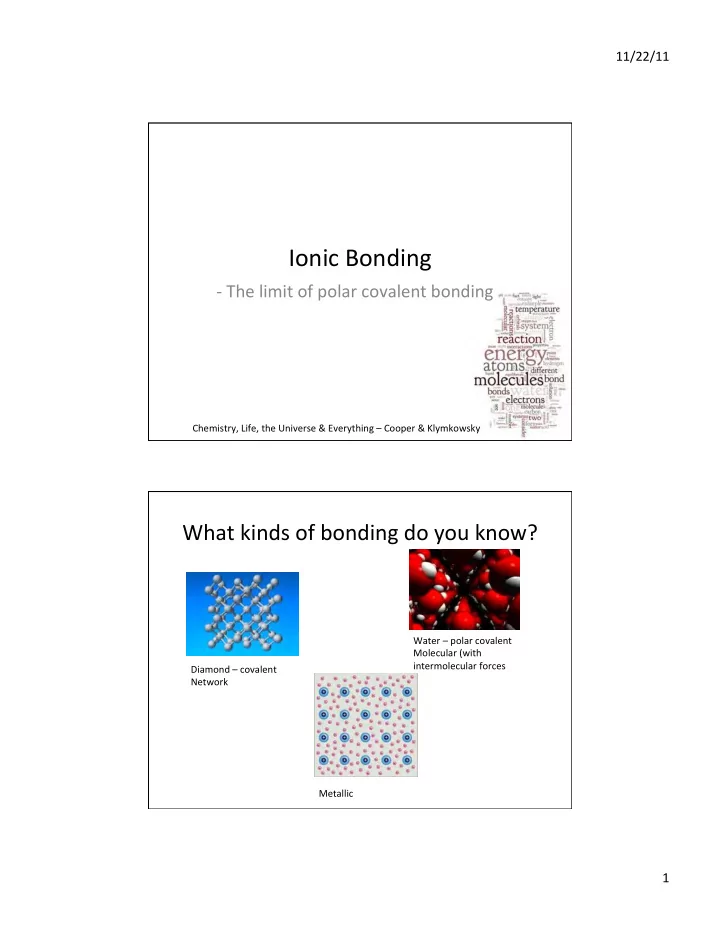

11/22/11 ¡ Ionic ¡Bonding ¡ -‑ ¡The ¡limit ¡of ¡polar ¡covalent ¡bonding ¡ Chemistry, ¡Life, ¡the ¡Universe ¡& ¡Everything ¡– ¡Cooper ¡& ¡Klymkowsky ¡ What ¡kinds ¡of ¡bonding ¡do ¡you ¡know? ¡ Water ¡– ¡polar ¡covalent ¡ Molecular ¡(with ¡ intermolecular ¡forces ¡ Diamond ¡– ¡covalent ¡ Network ¡ Metallic ¡ 1 ¡
11/22/11 ¡ There ¡is ¡no ¡such ¡thing ¡as ¡ a ¡“true ¡ionic ¡bond” ¡– ¡it ¡is ¡ yet ¡another ¡model ¡to ¡ help ¡us ¡understand ¡and ¡ predict ¡ QuesPons ¡ ¡ • What ¡is ¡an ¡ion? ¡ • What ¡is ¡an ¡ionic ¡compound? ¡ • What ¡is ¡the ¡difference ¡between ¡an ¡ionic ¡and ¡a ¡ covalent ¡bond? ¡ • What ¡kinds ¡of ¡compounds ¡are ¡likely ¡to ¡be ¡ ionic? ¡ 2 ¡
11/22/11 ¡ Recall: ¡ • Diamond ¡does ¡not ¡melt ¡(and ¡re-‑crystallize) ¡– ¡ because ¡covalent ¡bonds ¡are ¡broken ¡ • Water ¡(and ¡other ¡molecular ¡compounds) ¡melt ¡ and ¡re-‑crystallize ¡– ¡because ¡the ¡interacPons ¡ between ¡the ¡molecules ¡are ¡broken ¡on ¡melPng ¡ • Sodium ¡chloride ¡melts ¡and ¡reforms ¡– ¡what ¡ implicaPons ¡does ¡that ¡have ¡for ¡the ¡kind ¡of ¡ bonding ¡it ¡has? ¡ Other ¡properPes ¡of ¡NaCl ¡ • V ¡high ¡melPng ¡and ¡boiling ¡points ¡ • Conducts ¡electricity ¡when ¡melted ¡(but ¡not ¡in ¡ the ¡solid ¡– ¡so ¡not ¡metallic) ¡ 3 ¡
11/22/11 ¡ Which ¡is ¡bigger? ¡ • Na ¡atom ¡or ¡Na + ¡caPon ¡ • Cl ¡atom ¡or ¡Cl – ¡anion ¡ • Why? ¡ CaPons ¡ • PosiPvely ¡charged ¡ • Simple ¡caPons ¡formed ¡from ¡metals ¡losing ¡electrons ¡(ie ¡ elements ¡with ¡low ¡electronegaPvity) ¡ • What ¡is ¡the ¡rela+ve ¡size ¡of ¡the ¡ca+on ¡and ¡atom? ¡ Why? ¡ • Smaller ¡than ¡corresponding ¡atom ¡ • Charge ¡usually ¡corresponds ¡to ¡loss ¡of ¡electrons ¡back ¡to ¡ “core” ¡ but ¡not ¡because ¡this ¡is ¡more ¡stable ¡–loss ¡of ¡ electrons ¡always ¡requires ¡energy ¡ • But ¡highly ¡charged ¡ions ¡form ¡stronger ¡bonds ¡– ¡which ¡ are ¡more ¡stable! ¡ 4 ¡
11/22/11 ¡ Anions ¡ • NegaPvely ¡charged ¡ • Simple ¡anions ¡formed ¡from ¡non-‑metals ¡gaining ¡ electrons ¡(ie ¡elements ¡with ¡high ¡ electronega+vity ¡ • What ¡is ¡the ¡rela+ve ¡size ¡of ¡the ¡anion ¡and ¡atom? ¡ Why? ¡ • Larger ¡than ¡corresponding ¡atom ¡ • Charge ¡usually ¡corresponds ¡to ¡gain ¡of ¡electrons ¡ to ¡the ¡next ¡filled ¡(sub) ¡shell ¡ie ¡noble ¡gas ¡ configuraPon ¡ What ¡charge ¡do ¡you ¡expect ¡on ¡ • K ¡ • Mg ¡ • Al ¡ • S ¡ • N ¡ • Br ¡ • Fe ¡ 5 ¡
11/22/11 ¡ TransiPon ¡metal ¡ions ¡always ¡form ¡a ¡2+ ¡(and ¡usually ¡some ¡ others ¡as ¡well ¡ Sodium ¡Chloride ¡ 6 ¡
11/22/11 ¡ Ionic ¡compounds: ¡ • Metal ¡plus ¡non-‑metal ¡eg ¡NaCl ¡ • Metals ¡form ¡caPons, ¡non-‑metals ¡form ¡anions ¡ • Each ¡ion ¡typically ¡achieves ¡noble ¡gas ¡ configuraPon ¡ – ¡this ¡is ¡a ¡trade-‑off ¡between ¡ energy ¡required ¡to ¡gain ¡or ¡lose ¡electrons, ¡and ¡ stabiliza+on ¡of ¡the ¡system ¡when ¡ionic ¡bonds ¡ are ¡formed ¡ • Ionic ¡compounds ¡are ¡neutral ¡ What ¡is ¡the ¡formula ¡for ¡the ¡ compounds ¡formed ¡between ¡these ¡ ions? ¡ • Na + ¡ and ¡Cl– ¡ • Mg2+ ¡and ¡O2– ¡ • Al3+ ¡and ¡O2– ¡ • Mg ¡and ¡N ¡ • Ca ¡and ¡Br ¡ • Cs ¡and ¡S ¡ 7 ¡
11/22/11 ¡ Lafce ¡Energy ¡ • Energy ¡released ¡when ¡an ¡ionic ¡lafce ¡forms ¡ from ¡ions ¡in ¡the ¡gas ¡phase ¡ • Na + (g) ¡+ ¡Cl – (g) ¡ à ¡NaCl(s) ¡ • Force ¡of ¡agracPon ¡= ¡constant ¡(q + q – /r 2 ) ¡ • PotenPal ¡Energy ¡= ¡constant ¡(q + q – /r) ¡ • More ¡charge ¡– ¡stronger ¡agracPon ¡ • Larger ¡ions ¡– ¡smaller ¡agracPon ¡ ¡ Which ¡has ¡highest ¡lafce ¡energy? ¡ ¡ Which ¡has ¡the ¡highest ¡melPng ¡point? ¡ 8 ¡
11/22/11 ¡ Which ¡has ¡highest ¡lafce ¡energy? ¡ ¡ ¡ Which ¡has ¡the ¡highest ¡melPng ¡point? ¡ ¡ Electrolysis ¡of ¡NaCl ¡ Na + ¡+ ¡e – ¡ à ¡Na ¡ 2Cl – à ¡Cl 2 ¡ ¡+ ¡2e – ¡ ¡ The ¡charge ¡is ¡carried ¡through ¡the ¡melt ¡by ¡IONS ¡ 9 ¡
11/22/11 ¡ QuesPons ¡ • Why ¡doesn’t ¡solid ¡table ¡salt ¡conduct ¡electricity? ¡ • Why ¡does ¡molten ¡table ¡salt ¡conduct ¡electricity? ¡ • Why ¡do ¡you ¡think ¡the ¡melPng ¡point ¡of ¡table ¡salt ¡is ¡so ¡ high? ¡(it ¡is ¡over ¡800 ¡°C) ¡ ¡ • Why ¡don’t ¡metals ¡tend ¡to ¡gain ¡electrons? ¡ ¡ • Why ¡don’t ¡non-‑metals ¡lose ¡electrons? ¡ ¡ • What ¡do ¡you ¡think ¡happens ¡to ¡the ¡size ¡of ¡a ¡sodium ¡ atom ¡when ¡it ¡loses ¡an ¡electron ¡to ¡become ¡Na + ? ¡Why? ¡ • What ¡do ¡you ¡think ¡happens ¡to ¡the ¡size ¡of ¡a ¡chlorine ¡ atom ¡when ¡it ¡gains ¡an ¡electron ¡and ¡becomes ¡Cl – ? ¡ Why? ¡ 10 ¡
Recommend
More recommend